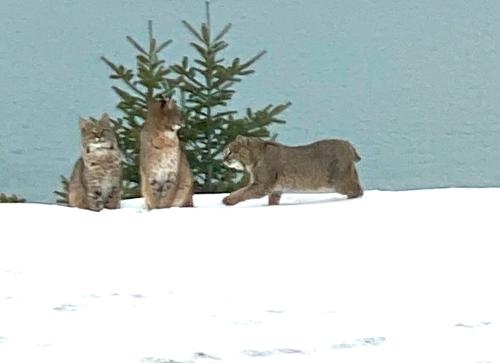 This photo of three bobcats in Leelanau County has gone viral on Facebook around here! The adorable big cats were perched on the bluffs of Good Harbor Bay in Leland just a few days before Christmas when Dan McDavid got the picture.
This photo of three bobcats in Leelanau County has gone viral on Facebook around here! The adorable big cats were perched on the bluffs of Good Harbor Bay in Leland just a few days before Christmas when Dan McDavid got the picture.
“My wife, Susan, and I looked out the window and saw two bobcats sitting there – and then a third walked up!” Dan said. He added that they have seen bobcats periodically over the years by their home, but this was a rare treat.
Soon after, UpNorthLive News Personality Joe Charlevoix posted the photo and it was shared almost 1,000 times in just a few hours! And while bobcats are not rare in Northern Michigan, catching one on camera is – let alone three!
For those hoping to see bobcats in the area, here are a few tips on their habitat and behavior.
Where can I see them?
- Bobcats are common but elusive and nocturnal. Keep a sharp eye out – bobcats are almost always on the move when you see them. They can run up to 30mph!
- Bobcats are afraid of humans and are unlikely to attack.
- They usually travel alone and at dawn or dusk. Most sightings are a few hours after sunrise or a few hours before sunset.
- Bobcats remain active year-round and do not hibernate.
- During the day, bobcats sleep and rest in dens, often in a hollow tree. They keep several dens in their home range. Their range is usually 6 to 25 square miles.
- You might see them in the forest, crossing the road – or on a bluff!
What do they look like?
- Their distinct feature is their short bobbed tail, which is 4-6 inches in length.
- They are two or three times the size of domestic cats.
- They weigh between 15-40 lbs.
- Their body is 2-3.5 feet long
- They have tufted, pointed ears with large, black spots on the backsides.
- Their back legs are significantly longer than their front legs.
- Their hunting running gait is another way that a bobcat lives up to its name: they sometimes run like a rabbit, placing their hind feet in the same place as their front feet. This style of running creates a bobbing appearance when they run.
Was that a bobcat… or a cougar?
- Bobcats are often confused with cougars. The differences: Bobcats have pointy ears and a bobbed tail, while cougars have small, rounded ears and a long tail (2-3.5 feet alone!). Cougars are at least twice as large as a bobcat.
- And… there’s still plenty of debate on whether Leelanau County even has cougars. Bobcats, however, are plentiful. Odds are, if you see a big kitty running through the woods, you’ve seen a bobcat – no reason to panic! Here’s what the National Park Service reports on cougars in the Sleeping Bear Dunes area.
What Do Bobcats Eat?
- Since most bobcats will avoid humans, they typically aren’t a threat to house pets near homes. They prey on mice, squirrels, small fawns, chickens, wild birds, and rabbits.
What do they sound like?
- Like most cats, they can be heard growling, hissing, meowing, yelping, screaming, howling, and squalling. And unlike most cats, barking!
- Bobcats communicate in response to fear, mating, anger, and predators. This website has an awesome – eerie and scary! – video of bobcat sounds!
- Bobcats are often said to sound like a woman screaming or a baby crying. They are more than a little unsettling to hear in the night!
Overall, if you happen to see a bobcat in Leelanau County, consider yourself very lucky! It’s like winning the lottery to see these majestic, elusive, and beautiful cats in the wild. If you see three – get a pic!
Thank you Dan McDavid for sharing your photo with us.
